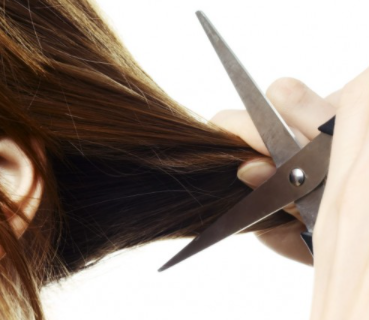According to salon school Columbus, Ohio, online and at beauty supply shops, instruments such as professional-grade haircutting scissors are widely available.
 But if haircutting scissors are hard to find, experts agree that with almost any sharp scissor you can do a good job. Spray a tissue with water and make a small cut into it to assess how sharp a couple of scissors are. Slightly dull scissors can be sharpened by cutting strips of sandpaper or multiple layers of aluminum foil. Experts say the safest way for men with short hair is not scissors, but an adjustable hair clipper with guards. These allow you to set the clipper, usually from 1/16 of an inch to 1 1⁄2 inches, to the length you want your hair to be.
But if haircutting scissors are hard to find, experts agree that with almost any sharp scissor you can do a good job. Spray a tissue with water and make a small cut into it to assess how sharp a couple of scissors are. Slightly dull scissors can be sharpened by cutting strips of sandpaper or multiple layers of aluminum foil. Experts say the safest way for men with short hair is not scissors, but an adjustable hair clipper with guards. These allow you to set the clipper, usually from 1/16 of an inch to 1 1⁄2 inches, to the length you want your hair to be. For straight or wavy hair, shoulder-length or longer: Cut any bangs first. Use a similar strategy to the one above if you have face-framing layers: clip back full-length strands, and comb forward layers. Keep the hair between your pointer and middle fingers when working in small sections, then use point cutting to snap off the ends.
For curly hair: Clip all but one tiny segment back. Through that part, run a comb, stop at your ends, then snip off the bottom quarter-inch only.
For natural black hair: Most of the time, if you wear curly hair, you can cut it that way. Pull one curl forward at a time while in front of a mirror. Concentrate on just trimming each curl's ends, cutting off no more than half an inch at a time.
Although your hair is probably cut when it's wet by your stylist, many say that amateur cutters work on clean and dry hair. Dry hair is more visual, meaning that when you cut, you can actually visualize what the end result would look like.
Then, with your scissors or clippers, a comb, hair clips or bobby pins if you have them, and a hand mirror within reach, set yourself up in front of a mirror.
For bangs: Collect the rest of your hair or clip it out of the way into a ponytail. Then comb all of your bangs and leave them in place on your forehead.
First, use a method called "point cutting:" instead of making horizontal cuts: keep the scissors vertically and create tiny snips into the bangs. For bangs or ends, for most amateurs, a perfectly straight line is too difficult; this will give the hair a smoother and slightly diffused line, so errors are more difficult to see. If the bangs are right below your eyebrows, stop.
For men's hair: If you normally wear your hair long enough to flow through your fingers, just trim your ears, sideburns, and neck with a clipper or trimmer. To make you feel less scruffy, that may be enough.
For hair for children: the methods are the same as for adults, but since children can be a lot of squirmier, hand them a book or tablet to concentrate on as you cut. You'll want them not only still, but looking down, to trim much of all except bangs.
